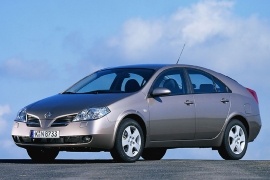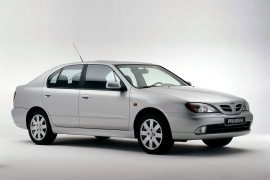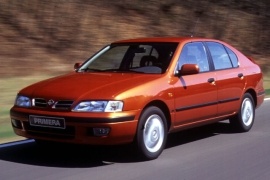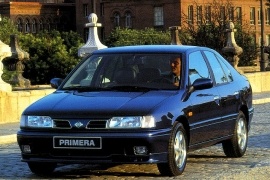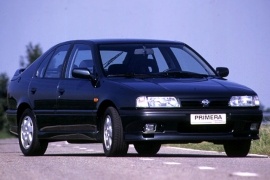NISSAN Primera Hatchback Models/Series Timeline, Specifications & Photos
First production year: 1990
Engines: Gasoline, Diesel
Body style: Hatchback
Starting in 2002, the third generation of the Primera was available in a hatchback shape to please those who needed more trunk space but liked sedans more.
After introducing the Primera in 2001 at the Frankfurt Motor Show in Europe, Nissan added the hatchback to the lineup in the following year. It continued a tradition that started with the Primera's first generation, the P10, in 1990. But now it was the 2000s, and the automaker had thrown all the technology it had in its basket into one car. Not only was the Primera P12 available with a rearview camera, but it also featured an infrared front camera that helped with the adaptive cruise control and an automatic braking system. Remember that it was 2002 when many cars were still offered without ABS. But not the Primera and its sibling, the hatchback.
Primera's styling had many bio-design influences but still sported many new-edge-inspired lines. Its front fascia, for instance, featured the flying-wing-themed grille that was broader than that of the previous generation. This was flanked by futuristic-looking headlights with a rhomboidal, swept-back shape. In addition, Nissan added another air intake in the lower part of the bumper to help cool the engine. Depending on the trim level, the automaker also added a pair of round fog lamps in the apron.
From its profile, the Primera Hatchback showed an almost identical shape to the sedan. It featured an arched line for the car's greenhouse with the roof followed by a sloped-down line for the tailgate. Unlike the sedan, though, this version had thicker C-pillars. Moreover, the broad rear window was fitted with a wiper. The corner-mounted taillights were tall and narrow, flanking the trunk opening. Nissan offered the Primera with either steel wheels for the lower trim levels or with a set of alloys.
Nissan installed a futuristic interior for the Primera P12. The dashboard sported a broad instrument cluster that sat on top of it, with the dials and gauges placed in the middle, not fronting the driver. Below, customers had the option to order the car with an infotainment system that could be controlled via a panel mounted underneath it. It featured a DVD-based navigation system, a climate control panel, and a stereo. Furthermore, it was also equipped with a reversing camera. The front mild bolstered bucket seats were comfortable and separated by a center console that housed an armrest with a storage compartment, two cup holders, the handbrake, and the gear stick. Behind, the split-folding (60/40) bench seat could easily accommodate three passengers and could expand the trunk size from 450 liters (15.9 cu-ft) to 1,812 liters (64 cu-ft).
Nissan offered the Primera Hatchback with a choice of three gasoline and two diesel engines at the start of sales. A third version followed later. The base models were fitted with five-speed manuals, while the punchier ones were mated with six-speed gearboxes. A CVT was also in the offer for selected versions.
Nissan refreshed the second generation of its mid-size lineup vehicle, Primera, in 1999, just three years after the model’s introduction, and one of the stars was the hatchback version.
While the sedan was selling more units than the rest of the Primera range, the hatchback was built in UK and had some aces up its sleeves when it came to delivery times. Nissan knew this, so it focused on increasing quality and providing the car with significant upgrades to make it more attractive to its customers. Unlike other mid-size hatchbacks from that era, such as the Ford Mondeo, the Primera looked more like a sedan.
When the automaker prepared the 1999 Primera, it focused on the car’s styling, which was not highly appreciated in the 1996 model. As a result, Nissan implemented the new design language with the “Flying wing” element on the grille, which was integrated into the hood. The headlights that flanked it sported a more organic shape, with curved lines and sharp inner angles. For the upper trim levels, these were fitted with Xenon brights that greatly improved nighttime driving situations. Lower, on the apron, the automaker installed a rectangular air intake to complement the cooling area. As an option, customers could get the Primera with fog lamps.
Nissan offered the Primera in a few grades, the most affordable ones being fitted with steel wheels and plastic caps. At the other end of the range, customers got it with light alloy wheels. From its profile, the 1999 Primera hatchback featured an ascending waistline with body-colored door mirrors and handles. Behind the rear doors, the C-pillars were wider at their bottom compared to the sedan. The sloped tailgate also featured a metallic flat horizontal beneath the rear window where the automaker installed a small wing. Finally, at the back, the smoked taillights were homologated to withstand parking bumps at speeds of up to 5 mph (8 kph).
Inside, the most noticeable change was on the dashboard, which was covered by a soft-touch plastic. As a result, the entire ambiance resembled the one from an upscale vehicle. Furthermore, the automaker offered the Primera Hatchback with a stereo integrated into the center stack, thus avoiding thefts. A CD changer and tape player were also on the options list. Fronting the driver was a rounded-shaped instrument cluster where the speedometer took center stage and was flanked by the tachometer on the left and the fuel and coolant temperature gauges on the right, above a small LCD for the odometer.
Under the hood, Nissan installed Euro 3 engines that were mandatory starting in January 2000. In addition, it introduced a new 1.8-liter powerplant. The automaker offered the Primera with a choice of five-speed manuals, four-speed automatics, and a CVT, depending on the engine and options.
Nissan launched the second generation of the Primera in 1996 and offered it in a few shapes, including the popular Hatchback, which stood between the best-selling Sedan and the spacious Wagon.
The Japanese automaker tried to keep up with its main rivals in the European market. Despite the Primera’s abilities as a driver’s car, it lacked behind the newly introduced and refreshed Ford Mondeo or the Peugeot 406. Even though the Primera P10 (the first generation of this moniker) was praised for its reliability, its sales were less than what the automaker expected. So, with the second generation of the Primera, the car became even more attractive in terms of engineering and safety. Unfortunately, Nissan didn’t pay enough attention to the design trends of the market, and as a result, the P11 looked outdated from the moment it reached the showrooms.
When the bio-design trend, with its curved lines inspired by organic elements such as eyes, leaves, or water surfaces, appeared on cars, the wedged shapes suddenly looked outdated. The P11 Primera featured a front fascia that resembled its predecessor, with its horizontal headlights, almost rectangular, but with angled-down inner sides. Between them, the flying-wing grille imagined as a design language by Nissan’s styling department didn’t look that much different from the one mounted on the P10. As a result, even if the car was completely new, it looked more like a refresh rather than a new generation. Still, the lower bumper said something different thanks to its new wider grille and the curved outer lines of the fog lamps.
From its profile, the 1996 Primera Hatchback had a sporty-looking ascending beltline. Up to the B-posts, it shared the same panels as the Primera Sedan, while the C-pillars were wider and supported a sloped down rear window. Nissan also penned the car with a short deck integrated into the tailgate that could be adorned with a wing. Finally, the rear fascia sported broad taillights with clear lenses on the upper area for the reversing lights and the turn signals.
Inside, the automaker installed a new dashboard that matched the mid-90s design trends. Fronting the driver was an instrument cluster fitted with large dials for the speedometer and tachometer flanked on the outer sides by the fuel level gauge on the left and the coolant temperature on the right. The center stack housed the HVAC control panel and an integrated stereo that was paired to the car’s ECU as a theft-deterring device. In the back, the automaker installed a split-folding bench seat that could expand the trunk space from 505 liters (17.8 cu-ft) to 1,357 liters (47.9 cu-ft), making it more appealing than the sedan version.
Under its skin, the Primera P11 had a new platform. Even if some of its engines were carried over from its predecessor, those were highly appreciated by customers. Nissan said that the Primera was a driver’s car, and it was. Unfortunately, its exterior design was outdated.
Nissan added a final refresh for the first generation of the Primera in 1994, offering customers a better-equipped base model and adding a fresh look to a car that was already four years old.
The Japanese automaker produced the Primera in the UK and offered it in three shapes: the sedan, which was the top-seller, the Hatchback, and the Traveller. The five-door version tried to fill the needs of those who wanted a larger trunk compartment than the one offered by the sedan but didn’t want a station wagon. In addition, this version provided a wider luggage area opening thanks to a tailgate instead of a classic lid. Its only disadvantage compared to the sedan was the look of the rear end, but many considered that it was a worthy compromise, and in 1994, Nissan tried to sweeten the deal with a refreshed front end.
It was the second facelift of the Primera P10, and there were just a few details that made it stand apart from its predecessor. The front fascia sported a clear wing-design theme for the grille, which was flanked by wide headlights with narrowed inner sides. In addition, the corner-mounted turn signals were covered by clear lenses with amber lightbulbs. Lower, under the apron, the automaker installed a lip spoiler below the additional air intake that cooled the engine. As an option, customers could get the car with rectangular fog lamps.
From its profile up to the B-pillar, the 1994 Primera Hatchback shared all its body panels with its sedan sibling. It also shared all the upgraded parts, such as the light-alloy wheels available for higher-grade versions and the black door handles. Behind the rear doors, the hatchback featured a wider C-pillar than on the sedan. Nissan installed a window wiper at the back to clean the rear windscreen. The corner-mounted taillights were narrower than those mounted on the sedan. The automaker added a spoiler on the tailgate for the sportier GT version.
Inside, customers could find low-mounted seats with multiple adjustments, including height. The velour-wrapped interior wasn’t available in too many colors, and there was no option for leather seats. Still, the automaker improved the instrument cluster by adding a second LCD that showed the odometer to the existing one for the clock. In the back, the bench seat could accommodate up to three passengers. It could also fold down to increase the trunk space from 70 liters (16.6 cu-ft) to 1,290 liters (45.6 cu-ft).
The Primera Hatchback shared its drivetrains with the rest of its brothers. Its base engine was a 1.6-liter twin-cam gasoline unit that boasted over 100 HP (102 PS) and was paired with a five-speed manual. The same gearbox was available for the rest of the range, but there was also an option for a four-speed automatic.
Nissan replaced the aging Bluebird in 1990 with the Primera, a car designed for European customers, engineered to suit their driving styles, and built in England.
Designed with the European customer in mind, the Primera P10 was available in three shapes: sedan, hatchback, and station wagon. While the sedan was the most sought-after version, the hatchback was needed to compete against other European cars, such as the Opel/Vauxhall Vectra and the Ford Sierra. The Primera, on the other hand, was a new vehicle concept, and even if it didn’t excel in terms of styling, it was convincing thanks to its engineering solutions and interior quality. Furthermore, it was available in six grades, which helped customers find the one that could suit their needs and their pockets.
At the beginning of the ‘90s, car designers started to move from the wedged shapes of the ‘80s to rounded ones. As a result, the Primera’s first generation was a mix between these two trends. Its rectangular headlights had shaved corners but still had that rectangular look of the previous Bluebird. Between them, the automaker installed a slim grille shaped with two wings that were available with chromed surrounding, depending on the trim level.
From its profile, the Primera Hatchback shared its front parts, up to the B-posts, with its sedan sibling. It had the same raked windshield and tall greenhouse compared to the car’s overall height. The side panels were adorned by a black rubber stripe that crossed the vehicle from bumper to bumper, and the door handles matched its color. The door mirrors, on the other hand, sported the car’s body color. Depending on the grade and options, the Primera hatch featured steel wheels with plastic caps or light alloy wheels. Finally, at the back, the thick and raked forward C-pillars supported a wide tailgate. Unlike the sedan, the hatchback version had taller and narrower corner-mounted taillights instead of horizontal ones.
Nissan extensively used velour for the Primera’s interior, covering the seats, the door cards, and the transmission tunnel with it. Fronting the driver was a rounded-shaped instrument cluster that housed the large dials for the speedometer and tachometer. Nissan also included two smaller gauges for the fuel level and temperature gauges. As a final touch, a digital clock was included in the speedometer’s dial at the bottom on a black and white LCD. The front seats were similar to the ones offered in the sedan, while in the back, the automaker installed a folding bench seat able to host three adults. Thanks to the split-folding rear bench, the trunk could be expanded from 470 liters (16.6 cu-ft) to 1,290 liters (45.6 cu-ft).
Under the hood, Nissan installed a range of gasoline or diesel engines that sent their power to the front wheels via a five-speed manual transmission. The automaker also offered an option for a four-speed automatic.
